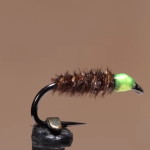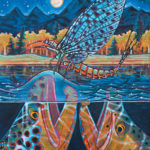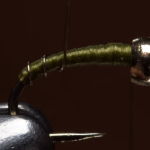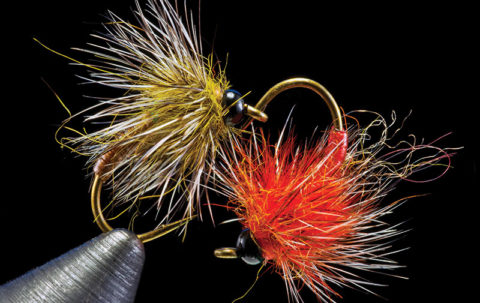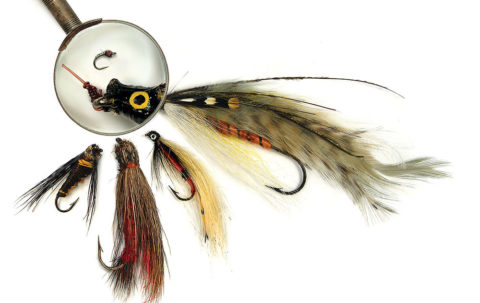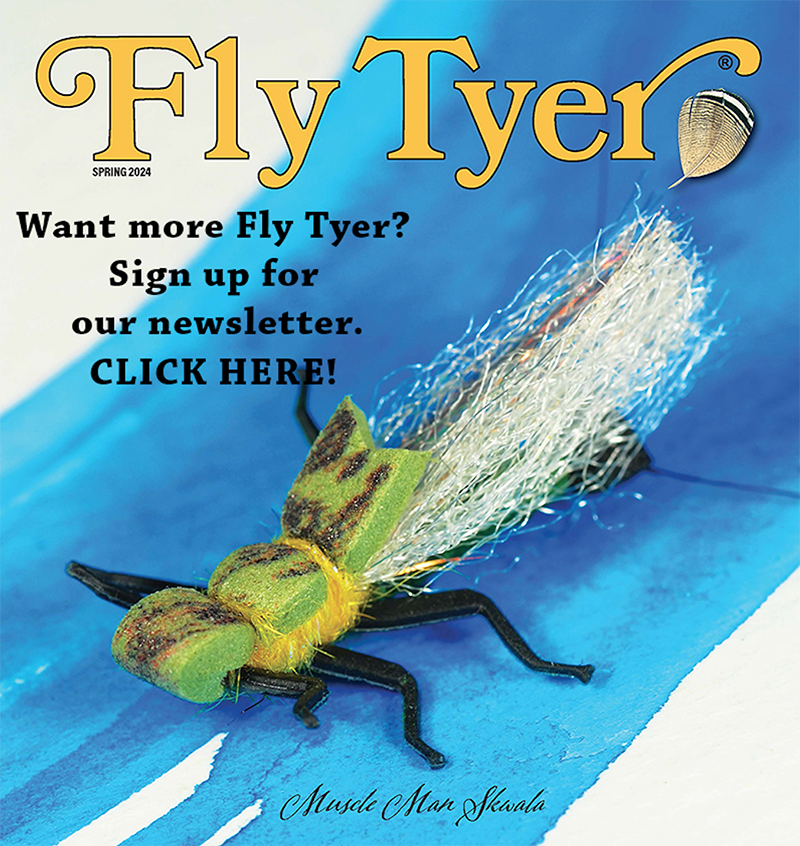I also like a Parachute Caddis in the same sizes, but I’m not sure why. Maybe it’s something about how they sit lower in the water, but are still easy to see. And although the trout are almost never selective except to size, I still like to have a backup pattern so that if I miss a good fish on one fly, I can come back at him with something similar, but a little different.

Flavilinea
HOOK: Mustad 94831, size 14 or 16.
THREAD: Brown 8/0 (70 denier).
TAIL: Elk hair or a substitute.
ABDOMEN: Olive biot.
THORAX: Olive dubbing.
HACKLE: Dun.
WING: Dun hen hackle tips.
I carry two all-purpose nymphs that I usually fish as droppers behind dry flies. One is a Hare’s-Ear Soft Hackle with blued bead-chain eyes; the other is a good old Pheasant Tail with a few turns of wire for weight under the thorax. I make both these patterns in sizes 14, 16, and 18 on Tiemco TMC200R hooks. If you backed me into a corner, I’d say the Soft Hackle is a caddis pupa and the Pheasant Tail is a mayfly nymph, but in practice, they serve as interchangeable sunken bugs for days when the fish seem shy about coming all the way to the surface for a dry fly.
I’ve been tempted by some of the neat foam hoppers I’ve been seeing and to which I might eventually succumb, but for now I still fall back on the Dave’s Hopper in sizes 12 and 14 for a grasshopper pattern. These work best on the lower, more open stretches of the creeks starting in August, when I notice I’m flushing small hoppers as I walk the banks. Hoppers are rare higher up on my home drainages, where it’s mostly spruce and fir forest, but I recently fi shed a meadow stretch of the West Fork of the Brazos way up at 10,000 feet in New Mexico and caught so many brook trout that I wore out two Dave’s Hoppers in a mile of creek.
I also carry a few Hare’s-Ear stonefly nymphs tied on size 8 and 10 hooks. I favor a slightly fancy pattern with split goose biot tails, a ribbed shell back, and drawn partridge hackle.

Dave’s Hopper
HOOK: Mustad 94831, size 14 or 12.
THREAD: Brown 3/0 (210 denier).
TAIL: Red hackle fibers.
BODY: Yellow polypropylene yarn.
HACKLE: Brown.
WING: Brown mottled turkey.
LEGS: Pheasant fi bers.
HEAD & COLLAR: Deer hair.
I hardly ever use these bigger nymphs in small streams, but I’ll sometimes try one in higher, early-season water or when I spot a good-sized trout holding deep and can’t get him to come up to a dry or dropper. If I fished these more often, I’d have long ago switched to a simpler pattern that would be quicker and easier to tie, but as it is, I feel I can get away with fishing the more elaborate flies simply because I like them.
That’s how the small stream box stands now, but it could well change because it’s changed before.
Patterns Tried and Discarded
I remember that for a few seasons, I carried some size 20 A.K.’s Olive Midge Emergers. I recall that because when I showed the box to my friend Ed Engle early one season when the flies were still all freshly tied and in neat rows, he nodded and said, “The midges are a nice touch.”
They were a nice touch, but they turned out to be more theoretical than practical. The fat little cutthroats dimpling in the quiet pool I’d envisioned either never materialized, or they did, but the fish were happy enough to eat a size 18 Hare’s-Ear Parachute. In any case, I eventually moved the midges into another box, where they’d see some action.
I also used to carry some Red Quills in a couple of sizes because they’re another common mayfly on these creeks, but I never seemed to use them. The same goes for PMDs and Blue-Winged Olives as well as assorted mayfly spinners that were too hard to see on fast water.

Hare’s-Ear Soft Hackle
HOOK: Regular wet fly hook, sizes 16 through 12.
THREAD: Olive 8/0 (70 denier).
BODY: Hare’s-ear dubbing .
RIB: Copper wire.
HACKLE: Mottled hen soft hackle .
EYES: B lack bead chain .
HEAD: Black bead chain.
There have been other flies that came and went—but mostly went—and my small-stream selection is now approaching the bare minimum. I didn’t do this on purpose; it just sort of happened. At this point, I could probably get by with the Hare’s-Ear Parachute and the bead-chain Soft Hackle in the usual range of sizes, plus a few Dave’s Hoppers and maybe a stonefly nymph or two, just in case. In fact, based on the flies I’ve had to retie for that box over the last few winters, I come close to doing that now.
If it’s not already obvious, I should point out that none of this is intended as advice; this is just one of those stories that gives you a glimpse at another tier’s idiosyncrasies, for what it’s worth. I developed this small-stream selection—if you can call it that—gradually and haphazardly on a handful of small creeks here in northern Colorado. It’s at least regional if not downright local, although the same flies have also worked reasonably well at one time or another on small streams from northern New Mexico north into Alberta and British Columbia.
In the course of putting these patterns together, I’ve learned almost nothing about trout flies, a little bit about my own sense of appreciation, and a little more about the value of simplicity. But the real revelation was simply that if someone outfishes me on some little creek somewhere, it’s not because he has better flies; it’s because he’s a better fisherman.
John Gierach needs no introduction, but if we had to, we’d probably say that he is the author of Trout Bum, At the Grave of the Unknown Fisherman, and numerous other best-selling books. His most recent work, A Fly Rod of Your Own is available at www.simonandschuster.com
FLY BOX

Pheasant-Tail Nymph
HOOK: Regular wet fly hook, in 16 -12.
THREAD: Brown 8/0 (70 denier).
TAIL: Pheasant tail fiber tips.
ABDOMEN: Pheasant tail fibers.
RIB: Gold wire.
THORAX: Peacock herl.
WING CASE: Turkey.
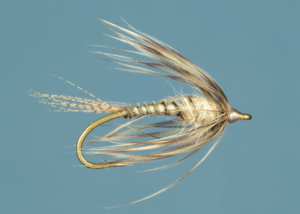
Olive Midge Emerger
HOOK: Curved-shank nymph hook, in size 18.
THREAD: Olive 8/0 (70 denier) .
TAIL: Wood duck or mallard flank fibers .
ABDOMEN: Olive biot .
THORAX: Olive hare’s-ear dubbing .
HACKLE: Mottled hen hackle .
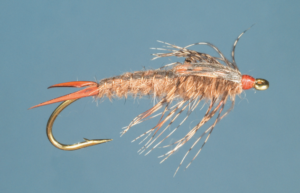
Hare’s-Ear Stonefly Nymph
HOOK: Curved-shank nymph hook, size 14 or 12.
THREAD: Olive 8/0 (70 denier) .
TAIL: Br own biots.
BODY: Hare’s-ear dubbing.
RIB: Copper wire.
BACK & WING CASE: Turkey.
LEGS: Teal or wood duck flank feather.

Damselfly Nymph
HOOK: Curved-shank swimming nymph hook, size 14 or 12 .
THREAD: Brown 8/0 (70 denier).
TAIL: Mallard flank fibers .
BODY: Hare’s-ear dubbing.
RIB: Copper wire .
WING CASE: Turkey.
LEGS: Teal or wood duck flank feather.
EYES: Black bead chain.
HEAD: Hare’s-ear dubbing.

